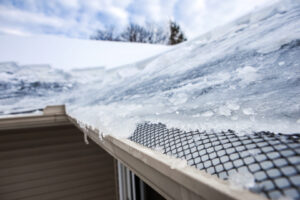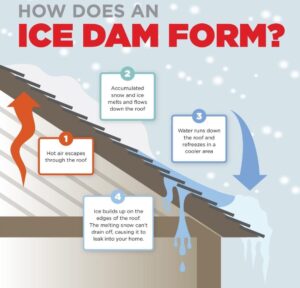As the winter chill tightens its grip on homes across Nashville, the picturesque sight of icicles hanging from

What are Ice Dams?
Icicles forming along the eaves of your house are a telltale sign of the same conditions that give rise to ice dams. These dams are thick ridges of solid ice that accumulate along the edges of roofs. The primary culprits are snow-covered roofs and freezing temperatures, creating an environment conducive to their formation.
The Dangers of Ice Dams:
While icicles may appear harmless, the consequences of ice dams can be severe. Here’s why they are bad news for your home:
- Gutter Damage: Ice dams have the potential to tear off gutters as they form and expand. The weight and pressure exerted by the ice can lead to structural damage to the gutters, requiring costly repairs.
- Shingle Loosening: As ice dams grow, they can loosen shingles on your roof. This compromises the integrity of your roofing system, making it more susceptible to leaks and other weather-related damage.
- Water Backups: One of the most significant risks associated with ice dams is the obstruction of proper water drainage. When melting snow or ice cannot flow off the roof due to the dam, it can back up under shingles, finding its way into your home.
- Interior Damage: Water seeping into your home due to ice dams can result in a cascade of problems. From peeling paint and warped floors to stained and sagging ceilings, the interior damage can be both unsightly and expensive to repair.
- Insulation Issues: Ice dams can compromise the insulation in your attic. Soggy insulation loses its R-value, making it less effective in regulating indoor temperatures. Moreover, damp insulation becomes a breeding ground for mold and mildew, posing health risks to occupants.
What To Do If You Have An Ice Dam?
Dealing with ice dams on your roof can be challenging, and while the temptation to tackle the issue head-on may arise, caution is paramount. In this blog, we’ll explore the importance of avoiding risky methods for ice dam removal and provide practical tips to minimize damage to your home.
- Steer Clear of Climbing Icy Roofs: Attempting to climb onto an icy roof to remove an ice dam is a hazardous endeavor. Not only is it unsafe, but temperatures in Middle TN often rise sufficiently within 2-5 days to naturally melt the ice. Patience can be a homeowner’s best ally in such situations.
- Use Calcium Chloride for Safe Melting: For those accessible ice dams, calcium chloride emerges as a safe solution. Applying it from a secure position, such as a ladder, can effectively melt the ice without risking damage to your roof. Avoid chiseling, torching, or using rock salt, as these methods can inadvertently harm your roof’s integrity.
- Quick Fixes for Interior Leaks: When faced with a leak inside your home, swift action is essential. Employ makeshift solutions like placing containers beneath dripping water to prevent further damage. If water accumulates in a ceiling leaving a bulge, consider popping a hole in the drywall to drain the water safely.
- Managing Exterior Wall Leaks: Leaks on exterior walls present a different challenge. Use towels to soak up the water in the affected area, changing them frequently to maintain effectiveness. In cases where containment is not feasible, consider removing baseboards and cutting out the bottom of the drywall to allow water to exit the wall.
Preventing Ice Dams:

- Adequate Insulation: Ensure that your attic is properly insulated to maintain a consistent roof temperature, preventing uneven melting and freezing.
- Ventilation: Proper attic ventilation is key to maintaining a cool roof temperature and minimizing the risk of ice dams. Adequate airflow helps regulate temperature and prevent the buildup of ice.
- Roof Snow Removal: Safely remove accumulated snow from your roof using a roof rake or hiring professionals. This reduces the potential for ice dams to form.
- Gutter Maintenance: Keep your gutters clean and free of debris to facilitate proper water drainage. This reduces the likelihood of ice dams tearing off gutters.
When Ice Dams Strike, Call A Reputable Roofing Company!
Ice dams demand careful handling to prevent both immediate and long-term damage to your home. By avoiding risky maneuvers, opting for safe melting solutions, and implementing quick fixes for leaks, homeowners can navigate through winter challenges with confidence. Remember, a measured approach ensures the well-being of your home and keeps winter troubles at bay.
As winter progresses, the threat of ice dams looms large. Understanding the dangers they pose and taking preventative measures can save homeowners from costly repairs and damage. MidSouth Construction in Nashville stands ready to assist those dealing with ice dam-related issues, emphasizing the importance of addressing the problem promptly to safeguard homes from winter’s icy grip.
